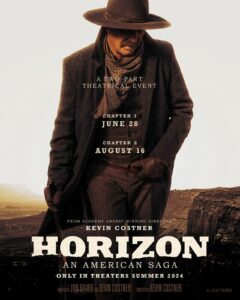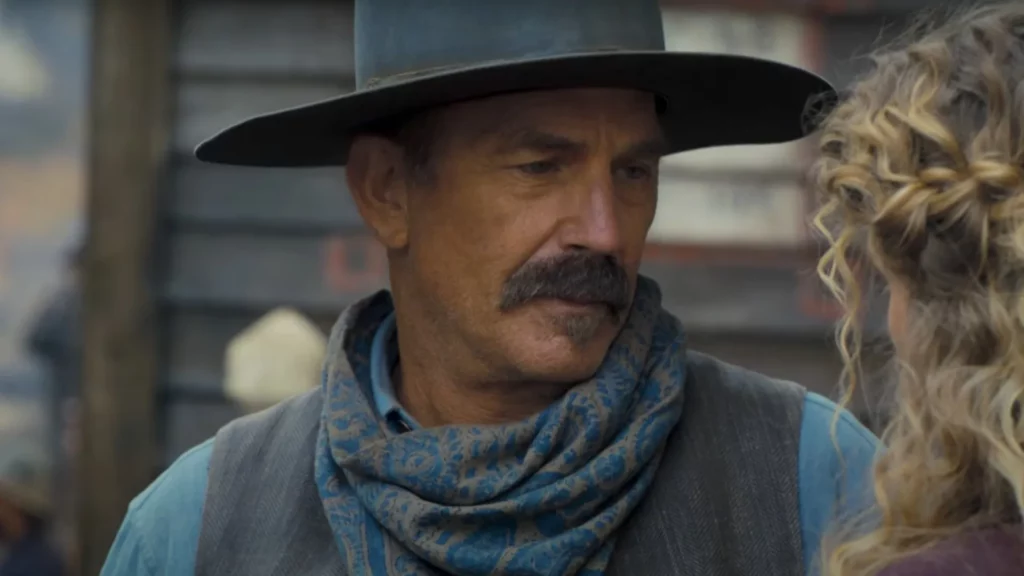Kevin Costner Begins his Epic Journey into the American West
DIRECTED BY KEVIN COSTNER/2024

My reviewing Horizon: An American Saga- Chapter One is complex due both to the film itself and my relationship as a longtime movie lover of my generation to it. As a fifteen-year-old in 1985, I experienced my first western in the theater, Silverado, and the genre has been number one in my heart ever since. I also took notice of the charismatic actor who played the rambunctious and a little crazy younger brother of Scott Glenn’s hero, who takes down two guys at once in a funny and cool moment in the film. As I came of age, Kevin Costner was the first actor I followed to ascendance as he also became a producer, director, and roughly between 1988 and 1993 one of the biggest stars, often accomplished through major gambles. That instinct also played into his drop-out from stardom.
Now, after both filmgoer and filmmaker have put some years behind them, Costner takes the biggest swing ever, one that speaks to fans like myself. Horizon is a planned series of what appears to be four epic movies in the western genre with multiple story lines and a dozen main characters told in a classic style. He had me halfway with the attempt alone. I stepped into the theater with the biggest screen I knew of ,with the whispers of tepid to bad I knew of, like a devoted eighties Cubs fan rooting for Kevin to knock that swing out of the park.
He establishes theme and tone right off the bat. A father and son stake out their future home. Above them, hiding in the rocks, two Apache boys view them, deducing it’s a game. Behind the boys, a group of warriors. We immediately get the idea of dreamers forging a new place out of the hard earth for a home and how that dream has encroached into the home of those indigenous to it. This sequence is expressed with the grand cinematography by J. Michael Muro using the Moab landscaping and matching score composed by John Dabney. I was hooked.

We soon learn we are starting in the year of 1859 and that parcel of land is a part of Horizon, a promised Utopia in the west a mysterious handbill sells. What that handbill doesn’t tell them is that the area sits on Apache hunting grounds. The first major set piece is a harrowing attack on the settlement. Much to the chagrin of Calvary officer Trent Gephardt (Sam Worthington) who has arrived to offer escort to the survivors to the safety of their fort, many decide to stay. Two that go with him are Frances Kitteridge (Sienna Miller), a newly made widow, and her daughter Elizabeth (Georgia McPhail) who adapt to the army life, developing relationships with the soldiers.
The movie kicks off two other plotlines. In Montana Territory, Jena Malone plays the mistress of a powerful outlaw clan’s patriarch, who shotguns him and takes off with their son. This sends the man’s three feral sons after her and the boy. Along The Santa Fe Trail, wagon master Matthew Van Weyden (Luke Wilson) struggles to keep the train moving and the community in order. We also have that boy planting stakes in the beginning falling in with a pack of scalp hunters led by an unscrupulous miscreant (Jeff Fahey, who must have a contract to be a villain in every other Costner western), a Chinese family searching for a place and struggling with racism, and two Apache leaders, one young, one old, at odds with how to deal with the Horizon settlers.
It takes an hour before Costner’s Hayes Ellison rides into the story in a big hero shot. Hayes works as a horse trader who possesses few words, a mysterious history, and a badass way with a gun. He’s a man looking to be alone, which in a western movie makes him ripe to connect to all these people and storylines. Not in Chapter One, though.
The lack of convergence is the root to many of Chapter One’s problems. A major part of the Kevin Costner origin story is him watching How The West Was Won at The Cinerama Dome. Horizon: An American Saga feels like the ultimate attempts to capture that feel of epic Americana he’s been pursuing as a filmmaker from Dances With Wolves on. He wants that huge scope with the story as well as the visuals.

Knowing this is the first in a four-part series, we can expect this film to mainly be set up. Costner tests those expectations to the limit. He delivers an episodic chapter within an episodic series. So many characters are introduced and we often don’t even get their names before Costner cuts to another story line with more people we’re introduced to. Many of the players can get lost in the shuffle, Chavez, a Chicano right hand to Gephardt, played with cool charisma by Alejandro Edda, gets short shrift. Sadly, so do the Apaches. Oddly enough, I feft this three hour section could use another hour.
Costner not only wants to portray all he can about western expansion, he wants to do it through applying many tropes of western film history. Hayes is cut from the Gary Cooper archetype and there are echoes of the Anthony Mann/Jimmy Stewart hero in Wilson’s Van Weyden. The cavalry scenes carry a John Ford depiction. Michael Rooker even channels Victor McLaglen as an Irish Sergeant. The three brothers feel they walked out of a Sam Peckinpah movie and the scalp hunters, who also could be comfortable in Cormac McCarthy’s Blood Meridian, could have been in one of the gnarlier spaghetti westerns.
However, there is little invention to the influences with exception of making it more epic. It also lacks the sense of adventure that many of us go to a western for. When Lawrence Kasdan executed his homage to the genre in Silverado, he wanted to express the vitality of the genre and leaned into its entertainment value with fun dialogue, popcorn action, villains we hate, and heroes we love hanging out with. Costner wants to get across the idea of the hardship of haw life in the west was. There is brutal violence, but there is little rousing action in it. The film portrays tragedy and poignancy but it contains little humor or romance in the classic sense.
All of that said, there are enough things for a western fan like myself to enjoy and make us look forward to Chapter Two coming out in August. Costner uses detail in great ways; from those stakes in the opening, a dying settler holding onto his fiddle, to dealing with sun warped wagons wheels. He creates a moving scene involving the embroidered flowers on a quilt pattern and a chilling one involving two pistols for sale in a trading post. It also plays into the visuals, like the reflection of a gunshot in a water trough. I only wished Costner splurged to shoot on film instead of digital to avoid the TV tinge to the look.

Many performances are some of the best in the actors’ careers with Costner sharing more of the screen than you’d expect. Worthington and Miller create a solid romantic chemistry. Danny Huston plays a stalwart Army colonel, delivering a strong monologue that explains an aspect of manifest destiny. Fahey builds a great character who’s means to survival has created someone evil. Another great bad guy is one of the brothers payed by Jamie Campbell Bower. He should get future work alone with his showdown with Costner’s Hayes. The standout is Luke Wilson, who plays Van Weyden with a reluctant authority that his character clings to with a touch of frustration. A part of me wanted Costner and he to switch characters.
Chapter One feels like the lope that stops right before it breaks into the gallop that will be Chapter Two, making it difficult to review on its own. Unlike many first film in something designed for a multi-movie series, there is no cliffhanger, major reveal, or even that moment of we’ve all gathered for the journey. Costner’s last two successes where in prestige TV with The Hatfields & McCoys and Yellowstone. He may be trying to apply that structure to the theatrical franchise. The last five minutes is a montage that basically serves as a trailer for Chapter Two with cinematic action, more striking visuals, as well as a possible revel of who is behind those handbills. There are also hints he may begin to subvert the genre tropes he established. Hopefully it will have more laughs and fun as well.
Horizon: An American Saga-Chapter One demands a lot of its audience, especially faith. It is all about establishing its story instead of telling it. For this diehard western lover though, it is one I overall enjoyed experiencing and want to support. If you’re someone who often who often says “They don’t make em’ like they used to.” It may be for you as well.

